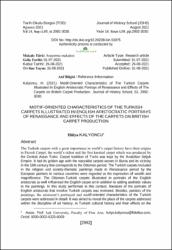| dc.contributor.author | Kalyoncu, Hülya | en_US |
| dc.date.accessioned | 2021-11-23T22:49:35Z | |
| dc.date.available | 2021-11-23T22:49:35Z | |
| dc.date.issued | 2021-08-31 | |
| dc.identifier.citation | Kalyoncu, H. (2021). Motif-oriented characteristics of the Turkish carpets illustrated in English aristocratic portrays of renaissance and effects of the carpets on British carpet production. Tarih Okulu Dergisi, 14(53), 2992 - 3030. doi:10.29228/Joh.51975 | en_US |
| dc.identifier.issn | 1308-5298 | |
| dc.identifier.issn | 2148-4260 | |
| dc.identifier.uri | https://hdl.handle.net/11729/3300 | |
| dc.identifier.uri | http://dx.doi.org/10.29228/Joh.51975 | |
| dc.identifier.uri | https://app.trdizin.gov.tr/makale/TkRZeE9Ea3hNUT09 | |
| dc.description.abstract | The Turkish carpets with a great importance in world’s carpet history have their origins in Pazırık Carpet, the world’s oldest and the first knotted carpet which was produced by the Central Asian Turks. Carpet tradition of Turks was kept by the Anatolian Seljuk Empire. It had its golden age with the naturalist carpets woven in Bursa and its vicinity in the 16th century that corresponds to the Ottoman period. The Turkish carpets included in the religion and society-thematic paintings made in Renaissance period by the European painters in various countries were regarded as the expression of wealth and magnificence. The Ottoman-Turkish carpets illustrated in portraits of the English aristocrats as well influenced the English carpet art in addition to adding aesthetic values to the paintings. In this study performed in this context, literature of the portraits of English aristocrats that involve Turkish carpets was reviewed. Besides, painters of the paintings, the aristocrat’s portrayed and motif-oriented characteristics of the Turkish carpets were addressed in detail. It was aimed to reveal the place of the carpets addressed within the discipline of art history, in Turkish cultural history and their effects on the British carpet production. In conclusion, it was turned out that they place premium on Turkish culture and art. | en_US |
| dc.description.abstract | Dünya halı tarihinde büyük önemi olan Türk halılarının kökeni, Orta Asya Türklerinin üretimi, dünyanın en eski ve ilk düğümlü halısı Pazırık Halısına dayanmaktadır. Türk halı geleneği, Anadolu Selçukluları ile devam etmiş, 16. yüzyıl’da Osmanlı dönemi Uşak ve çevre bölgesi halıları ile zirveye ulaşmıştır. Rönesans döneminde Avrupalı ressamların yaptıkları dini ve sosyal içerikli tablolarda görünen Türk halıları, zenginliğin ihtişamın ifadesi sayılmışlar, İngiliz aristokratlarının portrelerinde tasvirlenen Osmanlı-Türk halıları ise tablolara kattıkları estetik değerler yanında, İngiliz halı sanatına etki de etmişlerdir. İngiliz portre sanatında tasvirlenen Türk halılarının motif özelliklerinin, İngiliz halı sanatına olan etkilerinin saptanmasının amaçlandığı bu çalışmada yöntem olarak, İngiliz aristokratlarının Türk halıları ile göründükleri portre çalışmalarının literatür taramaları yapılmış, tabloların sanatçıları, betimlenen aristokratlar ve Türk halılarının motifsel özellikleri detayları ile ele alınmıştır. Dünya halı sanatına etki eden Türk halı sanatının her yönüyle geliştirilerek yaşatılmasının, Türk kültür ve sanatı açısından büyük önemi olduğu sonucuna varılmıştır. | en_US |
| dc.language.iso | eng | en_US |
| dc.publisher | Ahmet Kara | en_US |
| dc.rights | info:eu-repo/semantics/openAccess | en_US |
| dc.subject | Art | en_US |
| dc.subject | British | en_US |
| dc.subject | Carpet | en_US |
| dc.subject | Culture | en_US |
| dc.subject | Motif | en_US |
| dc.subject | Turkish carpet | en_US |
| dc.subject | Halı | en_US |
| dc.subject | İngiliz halısı | en_US |
| dc.subject | Kültür | en_US |
| dc.subject | Sanat | en_US |
| dc.subject | Türk halısı | en_US |
| dc.title | Motif-oriented characteristics of the Turkish carpets illustrated in English aristocratic portrays of renaissance and effects of the carpets on British carpet production | en_US |
| dc.title.alternative | Rönesans dönemi İngiliz aristokrat portrelerinde betimlenen Türk halılarının motifsel özellikleri ve halıların İngiliz halı üretimine olan etkileri | en_US |
| dc.type | article | en_US |
| dc.description.version | Publisher's Version | en_US |
| dc.relation.journal | Tarih Okulu Dergisi | en_US |
| dc.contributor.department | Işık Üniversitesi, Güzel Sanatlar Fakültesi, Görsel Sanatlar Bölümü | en_US |
| dc.contributor.department | Işık University, Faculty of Fine Arts, Department of Visual Arts | en_US |
| dc.contributor.authorID | 0000-0002-6325-6009 | |
| dc.identifier.volume | 53 | |
| dc.identifier.issue | 14 | |
| dc.identifier.startpage | 2992 | |
| dc.identifier.endpage | 3030 | |
| dc.peerreviewed | Yes | en_US |
| dc.publicationstatus | Published | en_US |
| dc.relation.publicationcategory | Makale - Ulusal Hakemli Dergi - Kurum Öğretim Elemanı | en_US |
| dc.contributor.institutionauthor | Kalyoncu, Hülya | en_US |



















